Mercy and more: Inside the works of writer/artist Mirka Andolfo
Mirka Andolfo talks DC Comics Bombshells, Harley Quinn, Mercy, and more

Looking at the work of Mirka Andolfo is looking across the spectrum of comics. From adult comedies to horror to anthropomorphic fantasy to, yes, superheroes, Andolfo's distinct style has been seen in almost every genre of the medium, not to mention the many different countries in which her work has been published. Currently, Andolfo is working on Mercy, an eldritch alien invasion being published by Image Comics.
Mercy is the story of a small mining community called Woodsburgh in the 1800s, as they are plagued by a series of bizarre murders - and coincidently, a new resident named Lady Hellaine.
WIth Mercy #5 due out August 26, Newsarama spoke to Andolfo about the book, plus the other comics that have put Mirka on the map, and finally, her upcoming animated project, Sweet Paprika.
Newsarama: Mirka, You have this incredibly distinct, very recognizable art style. Can you speak briefly about how you developed it?

Mirka Andolfo: First of all, thank you very much for appreciating my style.
To be honest, I never stopped thinking about "what style I would love to develop." I always inject my artwork with all that I love. When I was a child, I started reading Mickey Mouse magazine (as many children do in Italy, my country), and then I continued with a series called W.I.T.C.H. (which is also published in the U.S.), drawn by Alessandro Barbucci with amazing colors of Barbara Canepa. I think their style was the first one that really influenced me. Then I started reading a lot of manga, and when I was a teenager I discovered American comics (and European comics as well).
In general, I tend to "remember" artists I love, and "mix" what I see in my own way. So, it's difficult to say who influenced me the most. Apart from the aforementioned creators (I started my career as a colorist), I would say many American and Japanese artists and illustrators.
Get the best comic news, insights, opinions, analysis and more!
Nrama: Your first creator-owned book, Sacro/Profano (or Un/Sacred in the U.S.) is a sex comedy between an angel and a demon. Did you get any pushback for this book? Was it ever controversial?

Andolfo: I wrote and illustrated this book when I was still pretty young (it was 2012, so I was 23), and I started working on it as a sort of joke. I used to spend my work days coloring kids' books like Mickey Mouse and Geronimo Stilton, and I was in need of drawing something more personal, and especially nice girls (girls are the subject I prefer drawing, in general). As always happens with my projects, I started drawing the two characters in some sketches, and then the story came along.
So, to answer your question: to be honest, no, I never had any serious pushback for this book. It could seem like a "fan service sexy stuff," with a stunning (and naïve) blonde girl and a horny, awful demon, along with a story full of sexual jokes. But that's just the surface of the story. In general, sensuality is present in my books, and I try to tell stories about sex-positivity. That's the final message.
And that's the reason why, when Ablaze started publishing the book in English, I asked to have Marguerite Bennett localize it: I love her writing, and how delicate and sensitive she is, and I think she has fully respected the spirit of the book.
Nrama: After that came Contro Natura (Unnatural in the U.S.), set in the fantasy world of a pig-girl named Leslie. The book became an international hit, getting published in six different countries and several languages. In your opinion, what about this book resonated with so many readers?
Andolfo: Right now it's published in 10 countries, and another couple will be releasing shortly!
In any case, I'm not sure why it resonated with a lot of people (of course, it's something I'm happy for!). I think it could be because it's something 'strange' and 'different.' When you see the artwork and the world, it's colorful and happy, but the story is pretty dark.
And then, as for the storytelling, I think (or at least I've been told by many people), it straddles the line between 'classic' American comics, European comics, and manga.
In general, I think that my books have also been loved because of the social themes in them. And I want to say that it's not something I plan; the stories just come out, and after I write the first draft I realize what kind of themes I put inside…
With Unnatural, in particular, I think that anthropomorphic animals are still a niche, but still very loved. And I think that using them in a 'mainstream' story was something interesting for people.
In any case, I'm not the right person to say 'why' people appreciate my work because I honestly don't know… But I'm happy they do, of course!
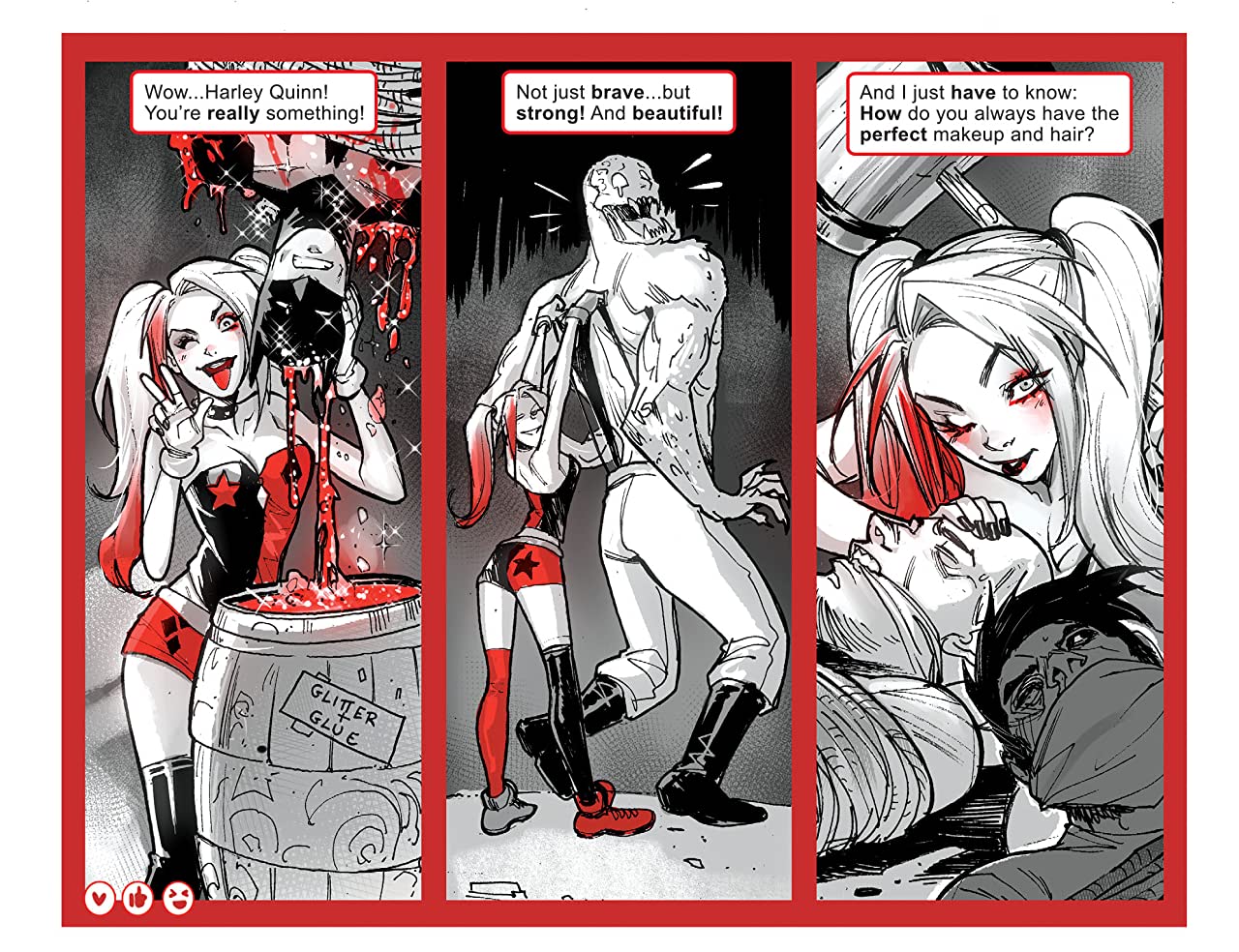
Nrama: Moving beyond your creator-owned books, you've also done a lot of work for several major comic titles, including Wonder Woman, Harley Quinn, and Ms. Marvel. What's your history with these characters? Did you grow up on DC & Marvel books?
Andolfo: I discovered American comics when I was already a teenager, but I loved them. I've never been a huge reader of superheroes, but I read some of them, and I must say I feel very lucky.
My second favorite character ever is Harley Quinn, and she's the character I drew in my first DC story (on DC Comics Bombshells)! Then I had the chance to draw such iconic characters, like Wonder Woman (with Greg Rucka and Shea Fontana), and also the first appearance in a comic page of the Batman Who Laughs!
In any case, even for the characters I didn't know very well before working on them (like Ms. Marvel), I quickly started loving them.
Right now I'm working more on covers and less on interiors, and that's also good, because I can draw more different characters. By the way, if you are curious about my favorite character ever… I don't know why, but when I say that during panels people start laughing… Well, it's Lobo. I love him. So badass!
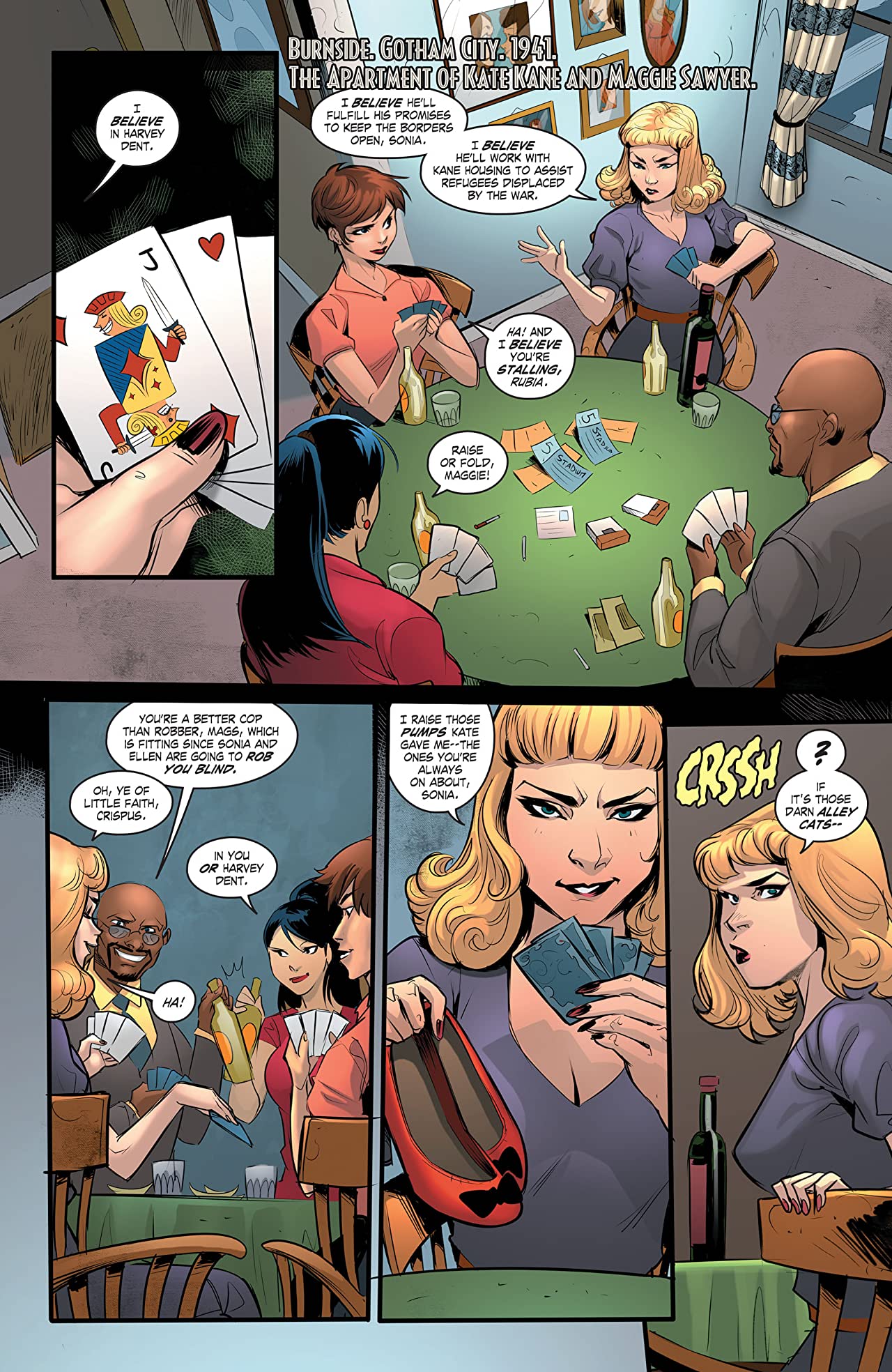
Nrama: As you've mentioned, you were one of the creators on DC Comics Bombshells, which was nominated for a GLAAD Media Award in 2017. What went through your mind when you heard the book had been nominated?
Andolfo: DC Comics Bombshells still has a big place in my heart, because it was my first (and so far my longest) DC assignment. I enjoyed the series (and I started collecting statues as well), and I had the chance to work with an amazing team, Marguerite [Bennett], the colorists, the fellow artists, and the editors.
When I was told about the nomination for the GLAAD Media Award, I was more than thrilled: I knew the passion of every single person behind the curtains of the project, and I think that this nomination was well deserved. Again, the story could seem 'simple' at first sight, more focused on the design of those (amazing) pinups characters, but a chapter is enough to understand the series' value. If you read a chapter, you understand the Bombshells universe and the message of the book.
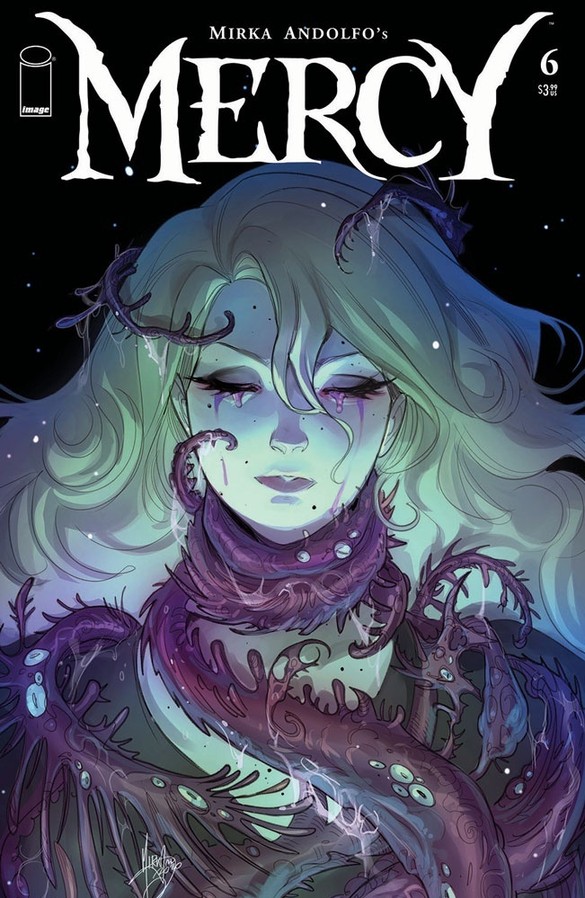
Nrama: Ok, now let's talk about the present. You're currently working on Mercy, a horror-fantasy period piece for Image Comics. Could you tell us how you pitched this book to them?
Andolfo: Like Unnatural before, this book was made for an Italian publisher (Panini Comics), so officially they pitched the book to Image. But I know how they do it because it's me (with the Arancia Studio crew, the studio where I serve as art director) who worked on a 'booklet' to pitch the miniseries. We printed the booklet (in the Italian version) for a meeting we had at Modena (where the Panini HQ is). It was 64 pages with the story, one page of comics, with many studies and pinups, the project for the IP development, and a moodboard as well.
Then we translated Mercy to English, it was sent to Image, and the publisher decided to release it in America (the book was licensed in the U.S. and France with Éditions Glénat before it was published in Italy).
When I work on a new project — both when I serve as a creator and when I'm 'just' Art Director — I prefer big presentations, usually a deck. I think it's very useful: at first, to clear your head about what you want to do, and then to show your audience your commitment to the project.
Nrama: Mercy takes place in the late 1800s, in the strange mining village of Woodsburgh, Washington. What interested you, as an artist and writer, about this time and place?
Andolfo: As I said about the art influences, I'm always influenced by what I love. And during that period I was passionate about very dark stories in movies, TV shows, and videogames. So there's a hint of Bloodborne and something from Penny Dreadful, as well as some Crimson Peak.
For the setting, I was looking for a cold area in the Victorian period, but not in Europe (it seemed something 'already seen' to me…). I wanted to give it a different twist, and I started thinking about the Seattle area. I do adore Seattle (it's probably my favorite place in the U.S.), and I started studying the Klondike Gold Rush, and I imagined what could have happened after, in an imaginary town, among the Seattle area and the Klondike… That's how Woodsburgh was born!
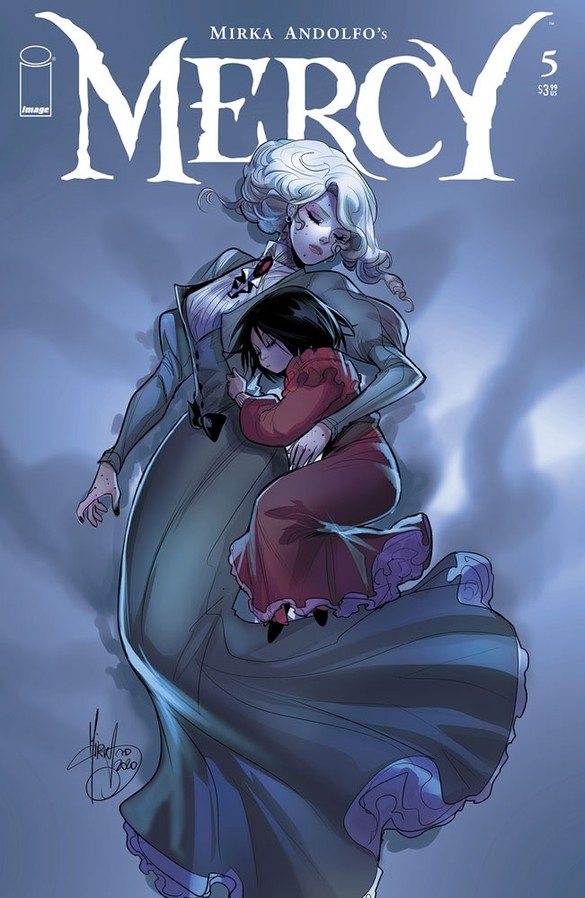
Nrama: There's a horror plaguing Woodsburgh, an alien entity that feeds on people. Can you speak to designing the creature(s)? Their look is absolutely horrifying.
Andolfo: I'm glad they are terrifying. It was very complicated to work on them, especially because I'm not used to 'horror,' and that's so personal. What I think is 'scary' maybe is not scary for other people. I tried to assemble an 'alien/tentacles/plant' being who possessed bodies, so it can control them.
For inspiration, I studied a lot of strange poisonous mushrooms that actually exist in nature, and I imagined the classic tentacle in a more 'natural' look, like poisonous plants.
Nrama: With the final issue about to come out, what's next for the citizens of Woodsburgh?
Andolfo: I cannot spoil, of course. What I can say is that the people from the town of Woodsburgh are not going to live in peace for long. The last two issues are (or, at least, should be in my mind) a crescendo of anxiety and danger. Little by little, the plan of everyone will be revealed.
Nrama: Outside of Mercy, what's next for you as a creator?
Andolfo: For my creator-owned work, I have at least four new projects coming in the next two years, and in a couple of them I'm just a writer. But it's too early to talk about that.
I'm also starting some new licensed projects just as a writer. As an artist, I'm working on many covers (at Boom!, but also for DC and Marvel, and other publishing houses), and I'm just starting a new DC book I'm enjoying a lot, but that's not yet announced.

Nrama: One of those future endeavors is Sweet Paprika, an animated project with a bit of an interesting history. Could you give us a brief rundown of how the idea came about, how people responded to it, and how it ended up becoming an animated project?
Andolfo: As with all my projects, I started drawing the characters and enjoying myself. Little by little, I started thinking about their relationship and the story behind them. The success, in terms of social media reaction, was unbelievable for me. People started asking me to draw them, even in commissions, sketches, etc., and I also had some couples cosplaying as Paprika and Dill.
The most-asked question in my live streaming (but also during the last shows) was "when will you write a story about Sweet Paprika?"
I was already thinking about that, and during a flight I re-watched The Devil Wears Prada, and I loved it even more than before (that's one of the main inspirations for the world-building). I started writing my ideas without thinking about the media I was writing for, and I was contacted by Grey Ladder (the production company we worked with for the Mercy live-action trailer), and they were so crazy — in association with Arancia Studio — to option the project, and decided to start development.
In any case, there are a lot of stories to tell about Paprika and Dill, and I can't wait to tell them. This will start in animation, of course, but I'm not sure that this will be the only incarnation for this I.P. (I can spoil that there will be merchandise announced after the summer…)!
Nrama: How does working in comics affect your work in other media? Specifically, how do you think it affects Sweet Paprika?
Andolfo: May I answer with "I have no idea?"
Working on animation is a new experience, and every day I discover something I wasn't aware of. Gabriele Pennacchioli is an amazing professional (like all the people on the team), and I'm learning a lot from him.
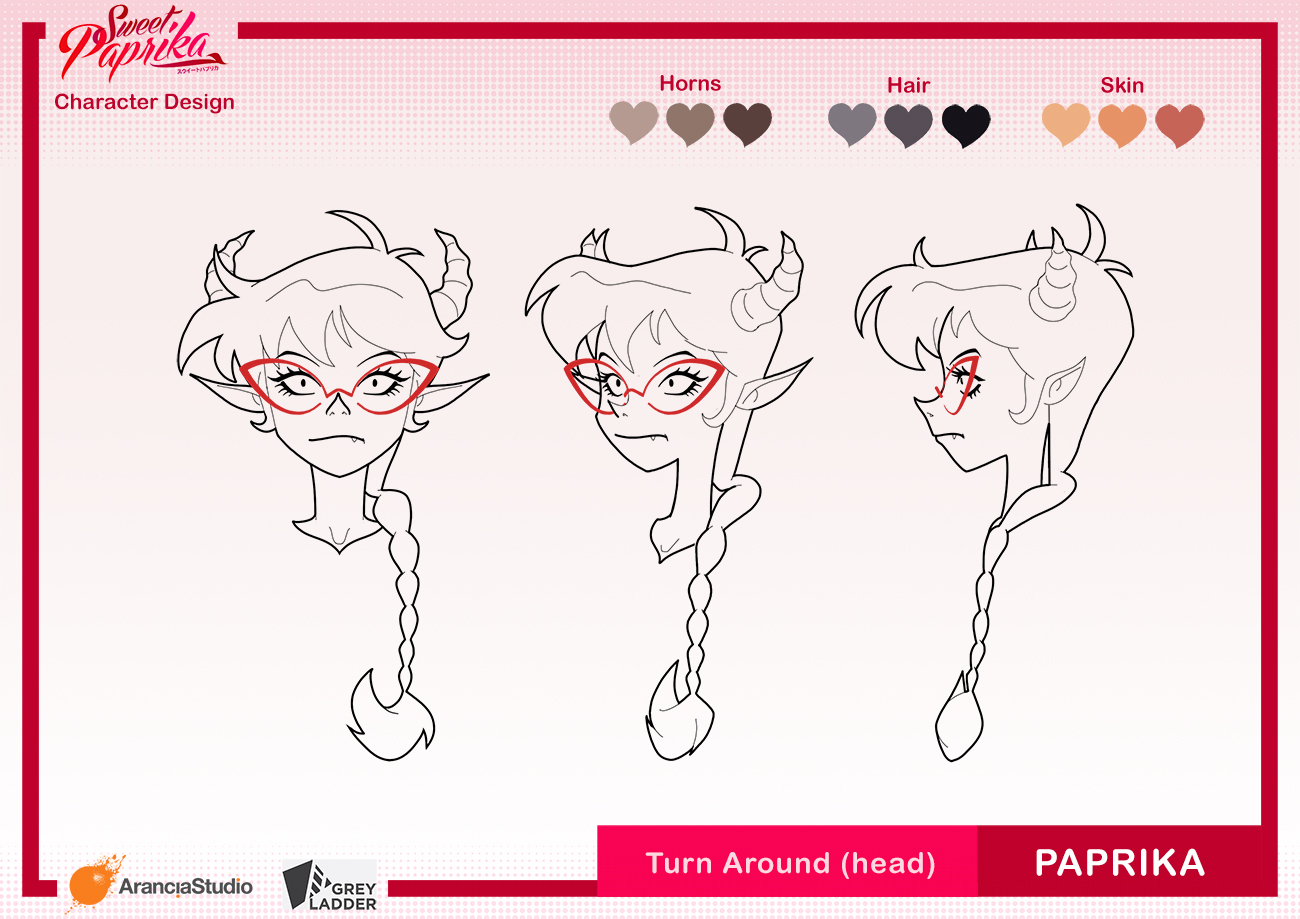
My work on comics for sure is helping to bring a 'different point of view,' especially about the gags. In general, even if the story is larger and more layered, Paprika was born with gags, and I think that one of my focuses as a creator is the humor, even in 'serious' stories. I will try to keep it in this project as well.
Nrama: On the flip side of that, how do you think working on Sweet Paprika will change your future comic projects?
Andolfo: After this experience, I'll be more aware of what other mediums are, how they work, and what the rules are, from a technical point of view. In general, I try to improve my stories, and in my mind, I try to work to make a new story better than the previous one. In that sense, I think an experience outside of comics will help.
I hope it will help me work better on my comics, because I'm a comic creator, and I strongly want to continue doing comics. But not only, of course! Working in other media is amazing: TV, movies… but video games? I would adore that!

Grant DeArmitt is a NYC-based writer and editor who regularly contributes bylines to Newsarama. Grant is a horror aficionado, writing about the genre for Nightmare on Film Street, and has written features, reviews, and interviews for the likes of PanelxPanel and Monkeys Fighting Robots. Grant says he probably isn't a werewolf… but you can never be too careful.


